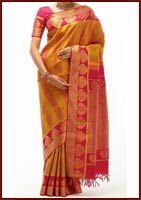
Indian culture is embedded with rich culture and heritage and is deeply rooted in traditions along with the rich culture. Indian Clothing is known for its elegance and traditional wear all over the world. As India has vivid and vibrant festivals to celebrate, there is no dearth of opportunities to shop here for beautiful Indian clothes. The elaborate wedding ceremonies further add to the list of celebrations and prove to be a fabulous excuse to shop for gorgeous Designer Indian Clothing. It is no secret that Indians are vivacious people and hence their clothing, too, tends to be bright and vibrant. Indian clothing not only enjoys huge popularity in U.S., U.K and other European countries but there is a huge market for Indian clothing in Australia too.
When it comes to celebrations and festive occasions in India, getting the right Indian Clothing becomes most important. It can be said that without the right Indian Clothing, there is no fun in indulging in revelry and merriment. Indian Clothing for women includes Saree, Salwar Kameez, Churidar Kameez, Kurti, Lehenga Choli, Ghagra Choli, Chaniya Choli, etc. Indian Clothing for men comprises Kurta Pyjama, Sherwani, Churidar Kurta, Shalwar Kurta, Afghani Suit, etc. With a plethora of fabrics and styles to choose from, it becomes quite difficult to choose the right outfit for the right occasion. When it comes to ordinary everyday Indian Clothing, women in India are mostly spotted in Saree, Kurti, Salwar Kameez or Churidar Kameez while Indian men lounge in Churidar Kurta, Kurta Pyjama, Shalwar Kurta, Afghani Suit, etc. For special occasions, Indian Clothing such as Lehenga Choli, Saree, Salwar Kameez, etc or Sherwani, Churidar Kurta, Jodhpuri Suit, etc are chosen by all Indian women and Indian men respectively. Though trendy designer wear outfits have become more popular nowadays, it is advisable to stick to traditional and classic Indian Clothing when it comes to traditional events such as festivals, pujas, weddings, etc.
Indian Saree
A sari or saree is a strip of unstitched cloth, ranging from four to nine metres in length that is draped over the body in various styles. It is very much popular in India, Bangladesh, Nepal, Sri Lanka, Bhutan, Burma, and Malaysia. The most common style is for the sari to be wrapped around the waist, with one end then draped over the shoulder baring the midriff.
The sari is usually worn over a petticoat "lehenga" in the north, langa/pavada/pavadai in the south, chaniyo, parkar in the west, and shaya in eastern India, with a blouse known as a choli or ravika forming the upper garment. The choli has short sleeves and a low neck and is usually cropped, and as such is particularly well-suited for wear in the sultry South Asian summers. Cholis may be backless or of a halter neck style. These are usually more dressy with plenty of embellishments such as mirrors or embroidery, and may be worn on special occasions. Women in the armed forces, when wearing a sari uniform, don a short-sleeved shirt tucked in at the waist. The sari developed as a garment of its own in both South and North India at around the same time, and is in popular culture an epitome of Indian culture. Indian sari is the most graceful and vivacious ethnic outfit that is primarily worn by Indian women. In India nothing identifies a woman as being Indian so strongly as the sari the quintessential Indian female garment. The 6 yard, unstitched, fluid garment over and around the body, adjusted with little tucks and pulls is one of the most graceful pictures ever. The sari undoubtedly is the most sensuous garment ever. And the best thing about it is that it conceals as much as it reveals. The sari is one of the most feminine outfits ever. And thats the secret behind its survival through various fashion eras like bell-bottoms, drainpipe and now low-rise jeans.
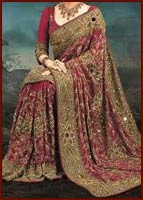
Indian saree is an unstitched long piece of cloth usually five to six yards sometimes as long as nine yard. Saree is wrapped around the body with one end tied around the waist and the other end called "pallu" neatly draped over the shoulder. Sarees can be draped in a variety of styles, with each style having its own uniqueness. The basic difference lies in the manner in which the pallu is wrapped.
Pallu is meant for show and thus is decorated beautifully with various kind of decorative designs and carvings. Sari is worn over blouse (also known as a choli). Underneath the sari one wears a Petticoat: - a waist-to-floor length skirt, tied tightly at the waist by a drawstring. Blouses of saree are usually in silk, cotton and velvet fabric. There can be different styles of blouse cuts like boat necked, square necked, blouses with straps,etc. Since time immemorial, Sari has been the most popular costume. It is an ideal clothing for the Indian culture, religion and climate. And is preferred by the Indian women because of the elegance and comfort it offers.
Sari fashion highlights the beauty of women in the most graceful and natural manner. Indian saris maintain the very essence of our Indian culture. Indian sarees come up in a variety of sari fabrics, exquisite styles, beautiful prints, exclusive embroideries like Zari, Resham, beadwork and studded stones with a palette of rainbow colors. Designer saree is very in of late. Sari is a dress for all seasons and virtually all occasions. Indian Wedding saris is a super hit among brides. It is considered to be the most perfect dress for the wedding day. When worn with proper fashion accessories and jewelry, Saris can do wonders to the charm of the bride. Sari is for all-purpose - party wear, daily wear, bridal sarees and so on.
Accessories which are needed to be worn with a sari are Blouse or a choli and a Petticoat.
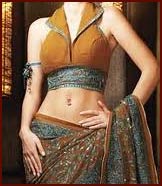
Choli: Choli, the tightly fitted, short blouse is worn under a sari. The choli evolved as a form of clothing in 10th century AD and the first cholis were only front covering; the back was always bare. Bodices of such type are still common in the state of Rajasthan. The choli is a tight fitting item of clothing, and adds a fashion statement to the sari. The sleeve length travels from full sleeves to half sleeves to sleeveless over a period of time. Cholis is a garment made of cotton or silk cloth and may or may not include a collar and sleeves. Cholis are generally more tailored than simple knit tops, and may contain "feminine" details such as ruffles or embroidered decorations.
A choli reveals more than it conceals. Its cut, color and the way it is worn would tell you about whether the woman is casual, carefree, bold, reticent or orthodox. One looking out for saree collection should also be particular sari but superb blouses to go with it, because the blouse can make or break the look of a sari, suggestions are beautifully embroidered blouses.
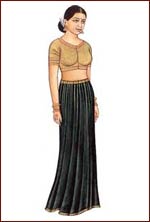
Petticoat: There is a petticoat, or a slip garment which is worn under the sari that holds the sari in place. A petticoat is a skirt which is worn under the sari. Petticoat is a waist to floor garment very similar to a lehenga or skirt, which is tied with the help of string or naada at the waist. A sari is wrapped over a petticoat. Petticoats are often made of cotton or polyester cloth. Usually a petticoat is of the matching color with sari. The sari is incomplete without a petticoat. The petticoat can be many in different varieties. They must have a firm waistband. Elastic will not do. One step on the petticoat and down comes the sari. The advantage of it is it gives a slim silhouette and using less fabric.
Varieties of Indian Sari
Every region of India has got its own unique sari style, as India has many culture embedded in it which differs in terms of fabric and weaving style. The exclusive range of Indian Saris includes:
Bandhani saree - Bandhani sari is classic style of Rajasthan and Gujarat. This sari is made by hand by the weavers that involve first tying and then dying of cloth. The sari is tied and died in such a manner that it produces elaborate patterns and designs on the fabric. Rajasthan is a city of beautiful bandhani saris.
Banarasi saree - Banarasi saris are the invention of Banaras City. The saree is popular among women and is widely appreciated an as exclusive silk sari. Banarsi silk sari's designs exhibit Mughal patterns. Banarasi sari in itself contains diverse styles like pure silk (katan), organza with zari work, georgette and shattir. Banarsi sari is ideal as a wedding sari.
Kanjeevaram silk saree - Kanjeevaram Indian saree is one of the finest and most popular forms of silk sarees in Tamilnadu. It uses a combination of colored threads and also has lot of zari work. Its major attractions are the beautiful tribal designs. Now focus is also on contemporary patterns. The saree has heavy gauge and is long lasting.
Cotton printed saris - The sheer varieties available in cotton sarees are just fabulous. They include batik work, bandhni style, block printing and hand made drawings. These saris are printed in large metropolitan cities like Mumbai and Kolkata. These cities have many sari stores.
Cotton handlooms - Cotton handlooms provide us with distinctive varieties primarily - Tant, Jamdani and Baluchari Bengal Handloom sarees. These styles are known for their lightness and are very comfortable. The saree's borders are meant to exhibit works of delicate silk threadworks. Designs are simple but artistic and unique. Peacocks, floral designs, architectural drawings are most often major attractions of these handlooms.
Printed chiffon sarees - Chiffon is a very durable, easy to wash fabric. Chiffon sarees usually come with very colorful prints in various combinations. They are very comfortable to wear and maintain.
Southern saree styles - Southern weaves include Pochampalli, Venkatgiri, Gadwal, Guntur, Mangalpuri sarees of Andhra Pradesh, Coimbatore and Chettinad styles of Tamilnadu, Bangalore silk sari, Mysore silk sari of Karnataka. Mysore silk is one of the most popular and finest and purest forms of silk. It is undergoing a makeover with new kasuti embroidery, bandhini designs and with a palette of exciting vibrant colors. Bangalore silk is a synthetic silk sari.
Embroidered saris - Embroidered saris are designer saris, made using different types of fabrics and designs to make this ethnic Indian attire gorgeous. The material used for the embroidered saris is flowing and graceful. Georgette, crepe, chiffon and silks form the basis for most of their creations. Designers work on the embroidery designer Indian sari and the most suitable color combinations and materials like kundan, zari, kori, and stones are used for the embroidery.
The age old Sari with great kind of culture has kept sari fashion very much popular throughout the centuries because of its total simplicity and practical comfort combined with the sense of luxury and sense of sexuality a woman experiences. The Indian sari has an ageless charm since it is not cut or tailored for a particular size.
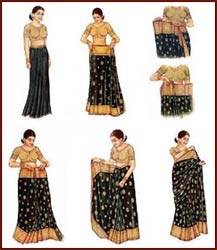
Two essential parts of wearing as saree, that goes along which need to be chosen carefully to compliment the Sari. They are:
A petticoat which is a waist-to-floor garment which is been tied tightly at the waist by a drawstring. This petticoat color should match the base of the sari color as closely as possible. No part of the petticoat, of course should be visible outside the Sari, after having worn it.
A blouse is a main attraction of the saree which needs to be tight-fitting and whose color needs to be chosen keeping the look of the sari in mind, can be short sleeved or sleeveless, with a variety of necklines.
How to wear a Saree
• Start wearing the sari by tucking its edge of the plain/upper end into the petticoat, at a position which is to the right of the navel.
• Make sure that other end of the sari should be touching the floor and even the whole length of the sari comes on the left-hand side.
• After this wrap the sari around once with the sari now coming back in the front, on your right side.
• A saree should have about 5 to 7 pleats of equal width of 5 inches, starting at the tucked-in end of the waist.
• Gather the pleats together, neatly, ensuring that the lower edge of the pleats are very much and just off the ground and that the pleats fall straight and evenly. A safety pin may be used to stop the pleats from moving away.
• Neatly tuck all the pleats into the petticoat at the waist, slightly to the left of the navel, in such a manner that pleat open to your left.
• Drape the remaining fabric of the saree around oneself once more left to right, and bring it round your hips to the front, holding the top edge of the sari.
• After this slightly raising the remaining portion of the Sari on towards back bringing it up under the right arm and over the left shoulder so that the end of the Sari falls to about the level of your knees.
• The end portion thus draped, from the left shoulder onwards is the Pallav or the Pallu, which is the most interesting part and can be prevented from slipping off the shoulder, by fastening it at the shoulder to the blouse with a small safety pin.
Gujarati way: Draping of pallu commonly known as the seedha pallu way, is also found in parts of Uttar Pradesh, Madhya Pradesh, Rajasthan and Bihar. Instead of opening to the left, the pleats are tucked so that they open to the right. Then, the pallu is taken to the back and brought over the right shoulder. It is then spread across the chest, and the left edge is tucked in the petticoat at the back.
Maharashtra method: Instead of the usual five-and-a-half meters, the sari measures eight meters. One portion of the sari is drawn up between the legs and tucked in behind at the waist, while another portion is draped pallu over the bosom. Thus it forms a kind of divided sari, allowing greater freedom of movement.
Tamilian version: Like the Maharashtra version, the saree in this version, too, measures eight meters. After wrapping around the waist, the pleats are positioned along the left leg. The rest of the sari is taken over the left shoulder, wrapped once again round the waist and tucked on the left side.
Bengali style: The sari is worn pleatless; it is wrapped around the waist, brought back to the right side and the pallu is thrown over the left shoulder. The pallu is then brought up under the right arm and once again cast over the left shoulder.



